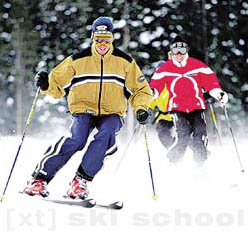|
Skis: They do wear out
Unless you are an accomplished skier, you will hardly be able to tell the difference between a lively new ski and an old worn in ski. It takes about 100 days on a pair of skis before they lose their camber and straighten out (commonly referred to as a dead ski). The camber can be judged by placing them together by the bases. When you squeeze the midsections together, the skis want to spring away. This is camber. Camber is much like a hunter's bow. If you pull the bow back, it will spring forward with force. The ski works on the same principal. If you put the ski on the snow by itself, the tips and the tails will touch the ground and the middle will be in the air. When you pressure the ski during a turn, the ski acts like a bow, loading up with stored force and shooting you into the new turn when the pressure is released. This effect is called rebound. When the ski is used a lot the ski loses its ability to rebound and becomes dead.
Beginner skis typically have little spring to start with, so the only visible sign of wear is from contact with rocks and the other ski. The difference between a lively ski and a dead ski can only be felt by a skier who knows how's to pressure the ski.
The second way a ski requires replacement is if the bottoms become badly damaged. Rocks often cause long gouges in the the soft base material which require filling with a P-tex candle (refer to the tuning and repair section). If the gouges are exceptionally deep and along the metal edge, the base will need to be professionally fixed. very rarely will the ski need to be replaced. The best ski shops employ technicians who are more like surgeons able to repair everything but the most extreme damage e.g. broken skis.
Alpine Skiing School section in english version of WWW.SKI.BG is based on
"A Guide To Becoming An Expert: From First Time To A Lifetime"
by John Mukavitz Copyright © 1998

|


